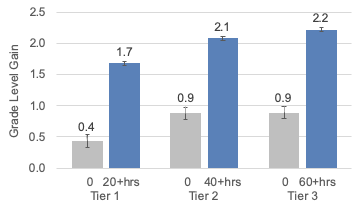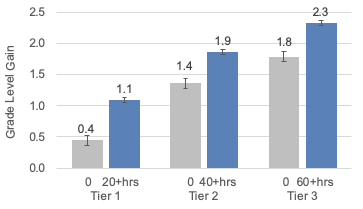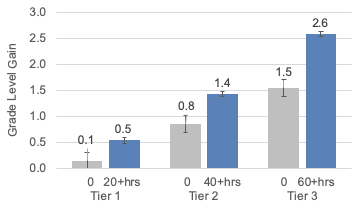
Summary of Findings:
This study reviewed the reading proficiency growth achieved by Reading Plus students in grades 2 through 12 during the 2018-2019 school year. The study focused on students who completed the InSight silent reading assessment on at least two occasions, once near the start of the school year and again during the spring, so that growth over the school year could be measured.
Study Design:
Included in the study were students (n = 259,140) who completed the InSight assessment in the fall of 2018 and spring of 2019. Among these were 46,007 elementary (grades 2 through 5), 133,543 middle (grades 6 through 8), and 79,590 high school (grades 9 through 12) students.
Reading proficiency growth was evaluated in relation to the amount of Reading Plus practice students completed. Within each grade group (elementary, middle, and high school), reading proficiency growth was also evaluated separately for each Reading Proficiency Tier group:
- Tier I – Students with Fall 2018 Reading Proficiency Index scores at/above grade level (recommended Reading Plus instruction: 20 hours)
- Tier II – elementary and middle school students with Fall 2018 Reading Proficiency Index scores 1-2 grade levels below grade level, and high school students reading at a middle school level (recommended Reading Plus instruction: 40 hours)
- Tier III – elementary and middle school students with Fall 2018 Reading Proficiency Index scores 3 or more grade levels below grade level, and high school students reading at an elementary school level (recommended Reading Plus instruction: 60 hours)
Key Results:
Across all grade groups and Reading Proficiency Tier groups, students who engaged in more Reading Plus instruction during the school year achieved reading proficiency gains that were significantly larger than those achieved by students who completed fewer or no lessons. The results also showed that students who engaged in more Reading Plus instruction developed more reading confidence and increased their interest in reading.
This study reviewed the reading proficiency growth achieved by Reading Plus students in grades 2 through 12 during the 2018-2019 school year. The study focused on students who completed the InSight silent reading assessment on at least two occasions, once near the start of the school year and again during the spring, so that growth over the school year could be measured.
Study Design:
Included in the study were students (n = 259,140) who completed the InSight assessment in the fall of 2018 and spring of 2019. Among these were 46,007 elementary (grades 2 through 5), 133,543 middle (grades 6 through 8), and 79,590 high school (grades 9 through 12) students.
Reading proficiency growth was evaluated in relation to the amount of Reading Plus practice students completed. Within each grade group (elementary, middle, and high school), reading proficiency growth was also evaluated separately for each Reading Proficiency Tier group:
- Tier I – Students with Fall 2018 Reading Proficiency Index scores at/above grade level (recommended Reading Plus instruction: 20 hours)
- Tier II – elementary and middle school students with Fall 2018 Reading Proficiency Index scores 1-2 grade levels below grade level, and high school students reading at a middle school level (recommended Reading Plus instruction: 40 hours)
- Tier III – elementary and middle school students with Fall 2018 Reading Proficiency Index scores 3 or more grade levels below grade level, and high school students reading at an elementary school level (recommended Reading Plus instruction: 60 hours)
Key Results:
Across all grade groups and Reading Proficiency Tier groups, students who engaged in more Reading Plus instruction during the school year achieved reading proficiency gains that were significantly larger than those achieved by students who completed fewer or no lessons. The results also showed that students who engaged in more Reading Plus instruction developed more reading confidence and increased their interest in reading.




